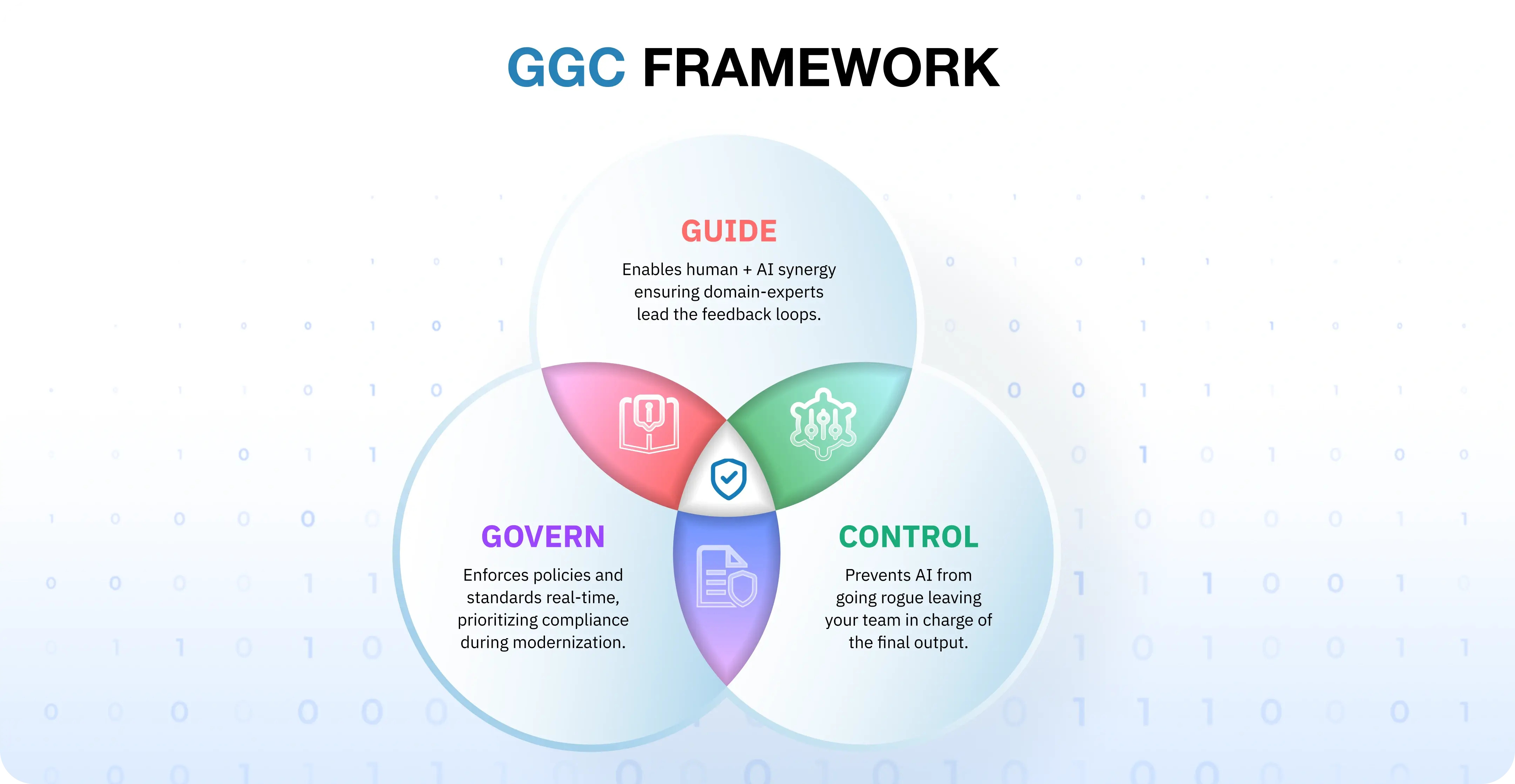70% of Your IT Budget Is Wasted on Legacy
Legacy systems drain your spend, slow your teams, and stall innovation. Modernize with speed, security and confidence — guided by our experts.
Pop quiz : What do Southwest Airlines' $140M “holiday meltdown” and CrowdStrike's ‘BSOD’ outage have in common?
Not talent shortage. Not budget constraints. Not technical complexity. At the core of these debacles was ‘outdated system failures’ – They paid the inevitable price of years of deferred legacy software modernization.
Although legacy systems translate directly into security breaches, penalties, lost revenue, and trust, for many enterprises, modernization still remains an uphill battle. Wakefield Research reports that 79% of enterprise application modernization projects fail – often after 16 months with more than $1.5M already spent.
That said, the difference between failure and sustained ROI often comes down to the modernization partner you pick. Which is why the real question isn’t “Should we modernize?” (that’s non-negotiable) – Instead it is : “Which partner to choose for the right legacy modernization solutions?"
Here’s How to Choose a Legacy Modernization Partner
Below mentioned are 7 criteria, each of which is a test of impact over optics for legacy software modernization service providers.
1. Technical Expertise in Legacy Application Modernization
True modernization expertise goes far beyond cloud certifications. It means being able to map undocumented dependencies, surface fragile integrations, and modernize with the broader business context in mind. The best legacy application modernization services don’t just rewrite code – they align modernization with ROI goals and growth ambitions – ensuring technology change actually drives business outcomes.
The best proof comes from enterprise case studies where partners adapted to user insights rather than forcing generic, recycled solutions. Watch out for partners who talk more about their pricing than their outcomes. The strongest ones bring legacy modernization tools like AppMod.AI to the table – uncovering hidden dependencies across sprawling code estates and translating “unknown fragility” into actionable roadmaps. But expertise alone isn’t enough – the partner must be able to turn that knowledge into a strategy that goes deeper than a surface level migration.
2. Strategy and Execution Beyond Lift-and-Shift
Cloud migration is not modernization entirely – it’s only the beginning. Real legacy system modernization moves through a lifecycle : Debt discovery → Architecture/Code changes → Cutover → Continuous optimization, all tied to KPIs like mean time to recovery (MTTR) or change failure rates. A genuine partner views modernization as a continuous process, not a one-off move.
This distinction is critical because research from McKinsey shows only 30% of digital transformations deliver sustained gains. The lesson is clear : execution must extend well beyond “go-live.” The right partner can show documented before-and-after metrics – reduced downtime, improved recovery – and prove that strategy connects directly to measurable execution across every phase. With phased modernization comes the need for old and new systems to run side by side.
3. Hybrid Coexistence with Intelligent Code Management
Enterprises can’t afford to switch the lights off while systems are rebuilt. Legacy application modernization has to be phased, allowing old and modern systems to coexist. This keeps operations stable while teams gradually transition. The right hybrid approach preserves business continuity, ensuring end users never feel the disruption.
A credible partner demonstrates this with pilots where legacy apps interact seamlessly with modern services in real time, showing declining errors and rising test pass rates. Avoid anyone proposing “big bang rewrites” or freeze windows that grind operations to a halt. The strongest players use AI code editors, real-time previews, and automated documentation to modernize incrementally while safeguarding knowledge transfer.
4. Security-First and Compliance-Ready
Security can’t wait until the end of the project – it has to be baked in from day zero. This means enforcing security with policy-as-code, role-based access controls, audit trails, and secret hygiene directly in the pipeline. Modernization without integrated security isn’t modernization – it's ‘risk’ disguised as ‘progress’.
A good partner shows how compliance is automated, not bolted on. Alignment with models like the GGC framework (Govern, Guide, Control) provides the structure : – Govern enforces policies and standards real-time, prioritizing compliance during modernization.– Guide enables human + AI synergy ensuring domain-experts lead the feedback loops.– Control prevents AI from going rogue leaving your team in charge of the final output.
If a partner promises to “add security later,” they’re exposing your enterprise to unnecessary risk.

5. Transparent Benchmarks and SLAs
Modernization partners who project ‘adjectives’ instead of ‘numbers’ are waving red flags. You should expect transparent metrics around automated code conversion accuracy, manual effort reduction, analysis speed, and time-to-first green build. Successful legacy modernization solutions must have measurable outcomes.
That’s why it’s essential to demand proof in your own environment, not just glossy decks. Targets like <2% compile errors or >80% first-pass test success should be non-negotiable. Partners and tools like AppMod.AI set a higher bar by publishing performance openly :
– 90% code review accuracy
– 70% faster analysis
– 80% manual effort reduction
Transparency is how you separate marketing spin from the true capability of a legacy modernization partner.
6. Change Management and Adoption, Not Just Code Delivery
True capability is also reflected when the partner doesn’t just ship code, but also ensures that users actually adopt the change. Harvard Business Review notes that 70–75% of transformations fail due to poor change management. Without adoption (end-users and employees), even the best systems become shelfware. Effective partners plan for user acceptance testing (UATs), training and steady-state handovers from day one.
A strong partner embeds best practices into the everyday experience of developers and end users, so that these stakeholders internalize the improvements until they become muscle memory. One of the key metrics to track smooth change adoption is whether support tickets fall or spike after go-live.
7. Integration Without Disruption
Modernization shouldn’t stop business in its tracks. The goal is to evolve systems behind the scenes while protecting uptime and continuity. This means designing integrations that slot seamlessly into existing CI/CD pipelines and business processes without interrupting the flow.
The most credible partners test high-risk integrations first, proving they can run modernization without business interruption. Beware of anyone pushing “big bang cutovers.” Instead, look for incremental integration powered by real-time previews, stepwise refactoring, and automated checks. When done right, legacy software modernization becomes invisible – users keep working, systems keep running, and the enterprise advances without missing a beat.
What Fortune 500s Expect From Their Modernization Partners
Every high-profile outage in the past few years underscores a single reality : Enterprises pay the price of delaying modernization – heftier than expected. Modernization, therefore, should be treated as a systematic transfer of risk out of your core systems and into a foundation built for resilience.
In 2025, selecting a modernization partner is not like picking another vendor – it is a strategic choice with direct implications on your business continuity, compliance, and competitive edge. The right partner is expected to demonstrate results on your codebase, in your environment, under real conditions. Realizing that, Fortune 500 companies are placing their confidence in AppMod.AI to deliver modernization at scale : 10× faster, at one-third the cost, with measurable gains in productivity. All this, with no disruption to live operations.
Let’s get the message right. Don’t modernize based on promises, do it based on proof – on your code, in your environment. That’s how legacy modernization solutions become shields for the future of your enterprise. Schedule a free consultation with our experts now. Let’s help you get modernization right!
Blog Summary
Legacy system failures cost enterprises millions through outages, breaches, and lost trust. Yet, 79% of modernization projects fail – often after months of effort and millions spent. The key difference between failure and sustainable ROI lies in choosing the right modernization partner.
This guide outlines 7 essential criteria – ranging from technical expertise and strategy beyond lift-and-shift, to change management and seamless integration – that separate true modernization partners from those offering just promises. Backed by industry data and case studies, it talks about the modernization platform Fortune 500 companies trust – to achieve modernization 10× faster, at one-third the cost, with no disruption to live operations.




